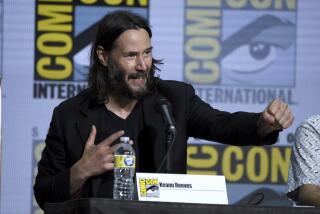Christopher Priestâs âInverted Worldâ imagines a city that crawls
Spoiler alert: Plot surprises in Christopher Priestâs novel âInverted Worldâ are discussed in the following column.
Itâs nearly impossible for me, a native Angeleno, to imagine a city like the one in Christopher Priestâs newly reissued novel âInverted Worldâ (New York Review Books: 322 pp., $15.95 paper). Here we have a city surrounded by high walls and a populace unaware that the entire polis sits upon tracks, pulled by a giant winch in order to stay ahead of a crushing, slowly moving gravity field. Thinking of the suburban sprawl that I call home, it is difficult to grasp living inside a portable society so finite as this one -- and that perhaps is one reason why the story is so intriguing.
But another reason for the storyâs appeal is the way in which Priest, with the novelâs very first sentence, immerses us within a strange new reality:
âI had reached the age of six hundred and fifty miles.â
The narrator, Helward Mann, is an apprentice in a guild system that keeps this city moving. There are guilds for laying track that recruit laborers from the areas the city passes through to survey the land ahead (which makes the menacing gravity field puzzling: Why donât the locals try to escape it?). Mannâs proud declaration about his maturity is a jarring revelation -- time in this world is measured best by distances.
We follow Helwardâs training in the guilds, in sections of first and third person point-of-view, and gradually learn that âthe city of Earth,â as it is called, has been crossing rivers, chasms and broad expanses for 200 years. Prior to that, some vague apocalyptic event called âThe Crashâ changed life on the planet. While various guilds concentrate on moving the city, its populace is shielded from the truth and focuses on raising and educating children and creating synthetic foods. (The cover of an omnibus edition of Priest novels published by Earthlight presents an interesting image of what the city looks like.) Such an imperiled world. There are many in recent imaginative fiction -- more than it is possible to list here, though Armada comes readily to mind, a floating city in China MiĂŠvilleâs âThe Scarâ that uses sea beasts to tow it across the ocean; and Deepgate, which balances in chains above a vast abyss in Alan Campbellâs âDeepgate Codexâ series (of which the second installment, âIron Angel,â has just been published); as well as âDaltharee,â a story by Jeffrey Ford about a world in a bottle in a new anthology edited by Ellen Datlow, âThe Del Rey Book of Science Fiction and Fantasy.â
Why do these fragile worlds captivate us so?
Is it because they jab at our assumptions that the modern city is entirely secure? Is it because we feel too safe just because thereâs concrete beneath our feet -- even though concrete can wobble like rubber as it did during Julyâs Chino Hills temblor?
Long before these philosophical considerations arise, Priestâs story is fascinating for a basic, practical reason: How, indeed, does one move a city? Much of the first half of the book is devoted to describing this extraordinary process, something suggestive of the building of the Pyramids or the laying of the Transcontinental Railroad. Here, Helward describes a tour guided by his teacher:
â[L]eading out from the northern edge of the city were five cables, which lay on the ground beside the tracks and disappeared from view over the hump of the ridge. On guard beside the track, pacing up and down, were several militiamen. . . .
âThe cables had been extended, and the stays were dug. He took me out to the stay-emplacements and showed me how the steel girders were buried deep into the ground to provide a sufficiently strong anchor for the cables. Three of the stays were completed and the cables were connected. One more stay was in the process of completion, and the fifth was being erected now.â
Then, the winch pulls the city about two miles. The tracks it has rolled over must be dug up and moved to the front again; the winch must be moved too. The goal is to reach something called the âoptimum,â a location always ahead of the city, a moving finish line that the city in fact never reaches but continues to pursue. The slowness of it all, the mind-boggling tedium, would be unbearable if it werenât for that crushing gravitational field behind and the optimum ahead. This is what gives the city its meaning -- a situation that, later, will explain much of what is going on.
Helward marries Victoria, whose father is an engineer, and their arranged marriage creates vibrancy and meaning in that otherwise surreal environment. So young and inexperienced, they stumble into lovemaking and into an understanding of the trust that must grow between two people. Victoria is eager to know what is going on outside the city; Helward has sworn an oath, punishable by death, if he should reveal anything of the field, a secret known only to those in the guilds. But the two realize that, if itâs not exactly love they feel, they care deeply for each other, and he shares some of the cityâs operation with her, leading her to this subversive response:
âDo you think it could be that those in charge of the guilds keep the system in operation after it has outlived its original purpose? It seems to me that the system works by suppression of knowledge. I donât see what that achieves. It has made me very discontented, and Iâm sure Iâm not alone.â
She isnât alone, in fact, and much discontent over the system causes a group, known as the Terminators, to call for the unthinkable: a halt to the city. In his afterword, John Clute points out that the bookâs appearance in 1974, during a decade of revolt and defiance against societyâs status quo, suggested to some early readers that the British authorâs story presented âyet another vision of a Britain deep in the doldrums.â
Helward is a devout guildsman but not without his doubts, not without a willingness to be affected by Victoriaâs questions. And yet, nothing prepares him for what he sees when he goes âdown pastâ: All apprentices are required to travel south of the city to see the threat for themselves. In addition to this, Helward is returning three young women to their town; they were âborrowedâ -- in exchange for medicines, foods, agricultural products -- for breeding. The traveling cityâs female population is declining, and for unclear reasons outsiders seem better able to produce female infants. As Helward and the women travel farther, the flatter everything becomes -- including the women:
âEven while they had been talking the process of change had continued. She was now a little more than twelve inches high, and her body -- as the other girlsâ -- was nearly five feet broad. It was impossible to recognize them as having once been human, even though he knew this to be so.â Helward loses sight of them in this bizarre landscape as heâs pulled southward, desperately gripping the ground, trying not to be sucked into space as the pressure increases on him. When he looks up, he sees a distorted landscape:
âNorth of him the ground was level; flat as the top of a table. But at the centre, due north of him, the ground rose from that flatness in a perfectly symmetrical, rising and curving concave spire. It narrowed and narrowed, reaching up, growing ever more slender, rising so high that it was impossible to see where it ended.â
When Helward finally returns to the city, he returns with a picture of their world as having the shape of a hyperbola -- warping forces to the north and south, while the place where conditions are most normal, the optimum, is at the center. He also finds that the journey affects his experience of time: Though he believes he was gone for a matter of days, Victoria waited a long time, suffered the death of their infant son and, giving up hope that she would see him again, remarried.
What is going on? Is this city on the Earth or not? The story that kept coming to mind as I read âInverted Worldâ was Shirley Jacksonâs âThe Lottery,â which describes another community going through the motions of a violent ritual long after the reasons for it have been forgotten. It is also true of the city of Earth: Few remember the circumstances of its creation and its founder, Destaine -- and then, an outsider reveals to all that Destaine was a scientist, an unappreciated one who developed a method of harnessing gravitational fields to create energy. The city has existed all these years inside one of these fields, which warps everything behind and before it. Once the generator is turned off near the novelâs end, the threat is gone -- and so is the reason for the cityâs desperate progress. Helward and the other citizens must let go of all their beliefs and customs to begin new lives. Here, as in Priestâs 1996 book, âThe Prestige,â lives are radically affected by a misunderstood genius lurking in the background (in the case of that novel, it was Nikola Tesla).
*
Clute writes that Helward is a mythological hero as defined by Joseph Campbell, a questing figure who goes âon a great adventure, during the course of which he begins to understand the true nature of his world.â In the realm of myth, however, âInverted Worldâ also reminds me of all those old creation stories found in just about every mythological tradition around the world. You know what these are: primitive images of the Earth as a small island surrounded by ocean or resting on the back of a tortoise (according to an Iroquois story) or floating in a water droplet or lying in the palm of a divinityâs hand.
In these world myths, human life occupies such a delicate, tiny space, threatened on all sides by the violent forces of the universe. These myths were intense efforts by people long ago to understand our place in the universe, and in âInverted World,â Priest gives us this myth again, placing it in a future where history, all chronicles, have been erased for the citizens of the city of Earth. This book shows us a community plunged into ignorance, trying to understand its place. You finish this novel appreciating our cultureâs efforts to protect its collective memories and also worried that everything we take for granted can easily be lost.
*
Nick Owchar is deputy books editor of The Times. The Sirenâs Call appears monthly at www.latimes.com/books
More to Read
The biggest entertainment stories
Get our big stories about Hollywood, film, television, music, arts, culture and more right in your inbox as soon as they publish.
You may occasionally receive promotional content from the Los Angeles Times.










